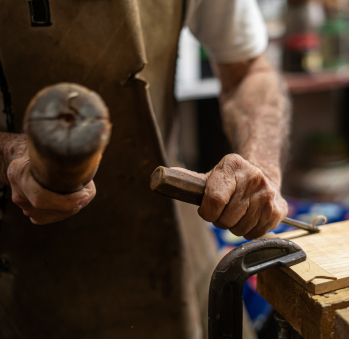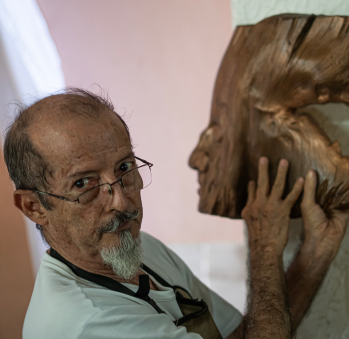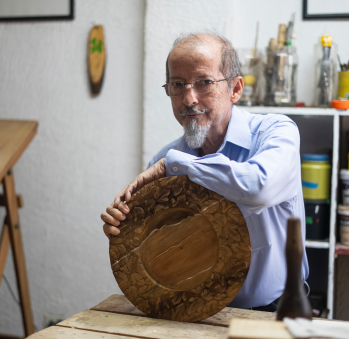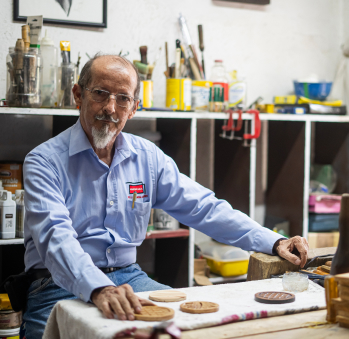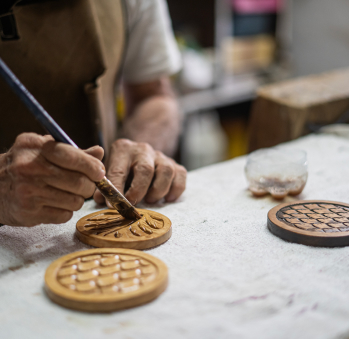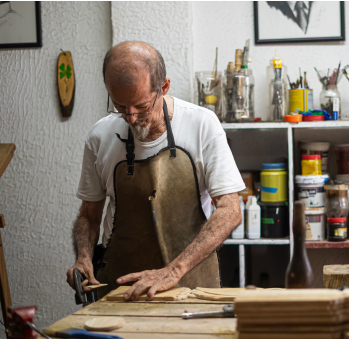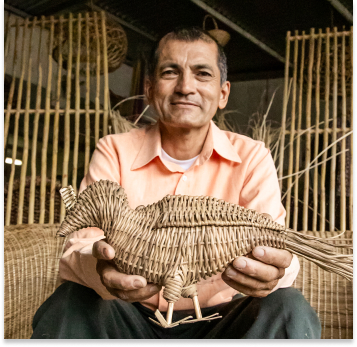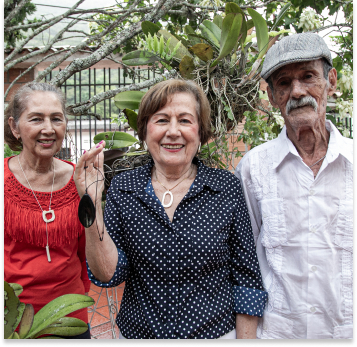Jesús Cáceres Nieto
Workshop: ARARTEC (Arte e Ingenia Caceres)
Craft: Trabajos en madera
Trail: Norte de Santander Route
Location: San José de Cúcuta, Norte de Santander
It’s a pleasure to engage in a conversation with Jesús, who has a lot to tell. This skilled artisan has a versatile range of interests, a curious spirit, and works with dedication on the things that appeal to his interests. He’s keenly aware of the finite nature of the resources he employs, which is why he passionately advocates for environmental research and tirelessly explores ways to enhance his beloved craft. Jesús combines the precision of exact sciences with his manual dexterity, much like an alchemist, blending precise amounts of honey, olive oil, and turpentine—just as ancient Mediterranean cultures did—to finish their creations and make them food-safe. Now in his seventies, he humorously remarks that working 25 hours a day is his secret to keeping the specter of Alzheimer’s at bay.
A preference for working with wood runs in his family. His father regaled him with tales of his grandfather, a man who handcrafted his own carving tools, ground his own coffee beans, and extracted his own sugar cane. His grandson affectionately refers to him as a “”wild engineer.”” Jesús speaks with reverence about this man named Justo Cáceres, who, armed with a hatchet long before chainsaws were available, fearlessly took on every challenge. The gift of resourcefulness was a legacy from Jesús’ father, Mr. Jesús María, who not only passed down his name and the tradition of woodworking but also bestowed upon him a second name: Ramiro. Trees, as we can see, serve as the unbreakable bond that connect these generations of men.
With charming eloquence, Ramiro notes that when he passes away, his presence will linger in three places: Arboledas, Durania, and Cúcuta. Although he was born in the capital, he spent a joyful childhood in the other two towns. He reminisces about carrying a leather pencil case, paints, paper, and fabric for sketching. He’ll never forget the day his teacher, Jaime, who bore a striking resemblance to the famous character Profesor Jirafales from the Chavo del Ocho T.V. show, instructed his students to draw eggs tied to their heads. On that day, he received a crucial lesson in abstraction and metaphors. He grasped the concept and, thanks to his innate talent, received an honorable mention for applying these novel ideas to his painting of the Sacred Heart of Jesus being devoured by termites. Later, as he watched his art teacher restore artworks, it became clear to him that his next step should be studying Fine Arts. He secured a scholarship and moved to Popayán.
However, he soon realized that he didn’t know as much as he had thought. He was on the verge of giving up, but once again, a teacher urged him to be patient. And his patience paid off when, a month and a half later, he was put in charge of coordinating the faculty’s workshop. Upon returning to Cúcuta, he dedicated his life to teaching crafts at Sena, where he eventually earned his retirement pension. He radiates admiration when discussing Colombia’s rich craftsmanship traditions, which he had the privilege to explore from the country’s four corners. He thoroughly enjoys meeting other master artisans, exchanging knowledge, and sharing their mutual love for their crafts.
Many years have passed before his eyes. He was told that his first cut would make him a true carver, and he eventually received it from the gouge, a tool used for hollowing out wood. His teacher taught him to feel the grain of the wood, savor its aroma, and appreciate its overall magnificence. This is why the Patula pines, which are abundant throughout Pamplona, have recently piqued his curiosity. Despite this coarse timber typically being used for crafting wooden pallets, Jesús Ramiro seeks to find a way to employ it in his craft due to the exquisite natural patterns etched into it. He’s actively researching methods to prevent the timber from warping, conducting experiments reminiscent of old practices—soaking it in water and then ironing it to restore its original shape. He understands that the key to enhancing the qualities of wood lies in thorough drying. He persists, tries, fails, and tries again, much like a scientist convinced he’s on the right track. Additionally, with the assistance of his son, an electromechanical engineer, they are exploring ways to use the roots from the Pamplonita River for creating lamps with rhizomatic designs.
Now that he has realized his city lacks a distinct identity, primarily due to its status as a transit point between Colombia and Venezuela, he aspires to capture the fallen leaves of Cúcuta’s trees in his crafts, thereby elevating the distinctive landscape of his city. He wants all of us to witness the intricate designs that blanket the ground when the leaves of the Oití tree descend. That’s why he carves them in low relief, providing a visual representation of his beloved Cúcuta.
Craft
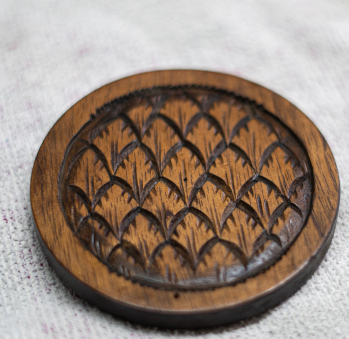

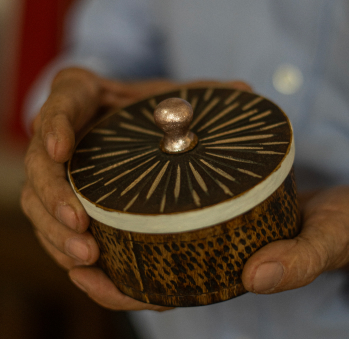

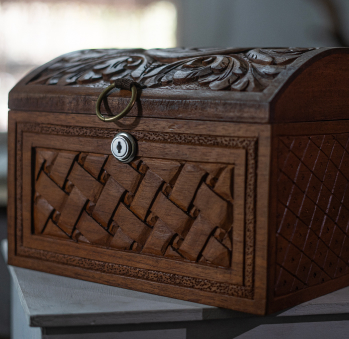
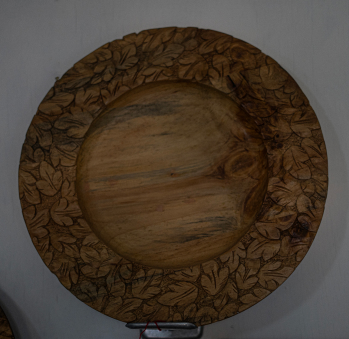
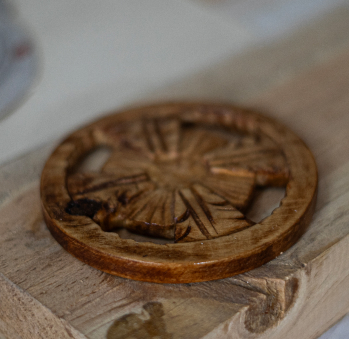
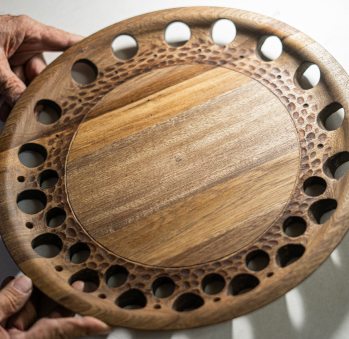








Artisans along the way
Artisans along the way
No puede copiar contenido de esta página









































